Along with the large cent, the half cent was one of our original coins dating to 1793. At the time of circulation,
their value was close to the value of our modern dime. However, they were never popular, and were generally minted
in much smaller quantities than the large cent. During the first year, there was fewer than one half cent minted
for every 100
citizens. In the 1850's (the final decade for the half cent), the ratio was the same. The half cent could never serve the needs of the public.
It was unusual for
anyone to ever get one in change.
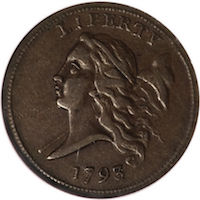
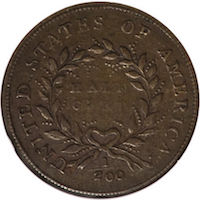 It has not been established who designed the first half cent, which is from 1793 with the head facing left. It had
been thought to be Adam Eckfeldt, whose main contribution to numismatics was saving the best specimens of coins as
they were minted and preserving them for future use. Modern numismatic scholars feel that the designer was more
likely to be Joseph Wright. However there is much doubt on that.
It has not been established who designed the first half cent, which is from 1793 with the head facing left. It had
been thought to be Adam Eckfeldt, whose main contribution to numismatics was saving the best specimens of coins as
they were minted and preserving them for future use. Modern numismatic scholars feel that the designer was more
likely to be Joseph Wright. However there is much doubt on that.
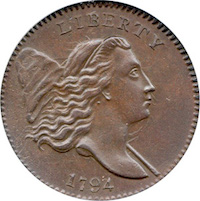
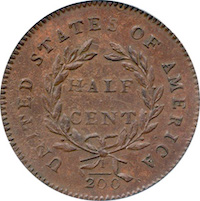
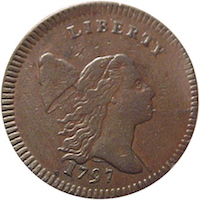
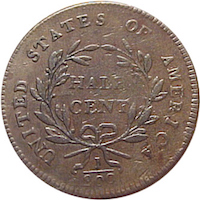
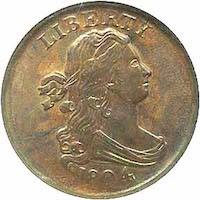
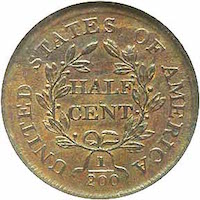
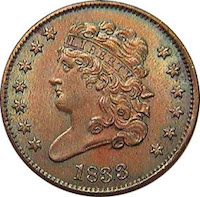

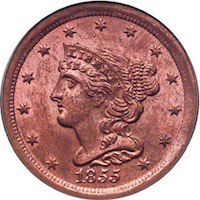
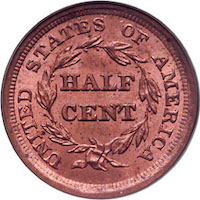 After 1835, there was a large gap with no half cents struck for circulation. During this time, many businesses minted their own copper tokens.
Regular issues of half cents did not resume until 1849, with the Liberty Coronet Cent.
After 1835, there was a large gap with no half cents struck for circulation. During this time, many businesses minted their own copper tokens.
Regular issues of half cents did not resume until 1849, with the Liberty Coronet Cent.
 .
Half cents are collected in many ways. Many collect them by type, in which there are six major types (I consider the 1794 a unique
type, although others lump it with the 1795 to 1797 coins). The first type, where liberty faces left is the most valuable. Even
well worn specimens sell for over $1000. Half Cents are also collected by date. My advice is to skip the proof only coins dated
1840 to 1849. A full set of these (including originals and restrikes) can run about $140,000. For the regular issue coins, the
key rarity is 1796, when only 1,390 half cents were struck. The vast majority of the surviving coins of that year will sell for
over $10,000, thus leaving a hole in most collectors' albums. Albums available for half cents include Dansco Half Cents 1793-1857 Album #7098
.
Half cents are collected in many ways. Many collect them by type, in which there are six major types (I consider the 1794 a unique
type, although others lump it with the 1795 to 1797 coins). The first type, where liberty faces left is the most valuable. Even
well worn specimens sell for over $1000. Half Cents are also collected by date. My advice is to skip the proof only coins dated
1840 to 1849. A full set of these (including originals and restrikes) can run about $140,000. For the regular issue coins, the
key rarity is 1796, when only 1,390 half cents were struck. The vast majority of the surviving coins of that year will sell for
over $10,000, thus leaving a hole in most collectors' albums. Albums available for half cents include Dansco Half Cents 1793-1857 Album #7098 and Whitman Harris Half Cents Album
and Whitman Harris Half Cents Album .
.
 .
.
Taxation and the US mint
In 1791, the federal government exerted its authority on monetary policy by authorizing George Washington to establish a mint (thus ending coinage by states) and by imposing a whiskey tax. In 1794, Pennsyvania farmers took up arms against the tax and were quelled by federal troops. It is in this environment that the minting of US coins began.Who designed the first half cent?

 It has not been established who designed the first half cent, which is from 1793 with the head facing left. It had
been thought to be Adam Eckfeldt, whose main contribution to numismatics was saving the best specimens of coins as
they were minted and preserving them for future use. Modern numismatic scholars feel that the designer was more
likely to be Joseph Wright. However there is much doubt on that.
It has not been established who designed the first half cent, which is from 1793 with the head facing left. It had
been thought to be Adam Eckfeldt, whose main contribution to numismatics was saving the best specimens of coins as
they were minted and preserving them for future use. Modern numismatic scholars feel that the designer was more
likely to be Joseph Wright. However there is much doubt on that.
Liberty changes direction




Other half cent designs




The Liberty Coronet Cent

 After 1835, there was a large gap with no half cents struck for circulation. During this time, many businesses minted their own copper tokens.
Regular issues of half cents did not resume until 1849, with the Liberty Coronet Cent.
After 1835, there was a large gap with no half cents struck for circulation. During this time, many businesses minted their own copper tokens.
Regular issues of half cents did not resume until 1849, with the Liberty Coronet Cent.
Liberty Coronet Proof Coins
Proof coins of the Liberty coronet series exist dated 1840 to 1849. These coins are referred to as original (distinguished by larger berries on the reverse) and restrikes. Although the restrikes were likely made after the so-called originals, it is likely that neither of these types were actually struck during the dates that appear on the coins. They may have been made by employees of the mint without knowledge of their director.The end of the half cent
The mintages for the liberty coronet cent were quite small. Neither the half cent nor large cent were popular. In 1857, the half cent and large cent were eliminated and the small cent was introduced.Collecting half cents
Half cents were ignored by most collectors through the mid twentieth century. Interest in half cents started with Roger Cohen's book, AMERICAN HALF CENTS The "Little Half Sisters"More information on half cents
More information about half cents can be found in the book, Walter Breen's Encyclopedia of United States Half Cents, 1793-1857